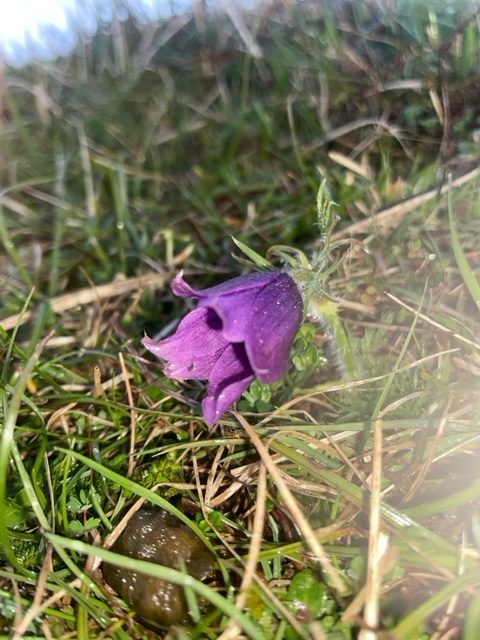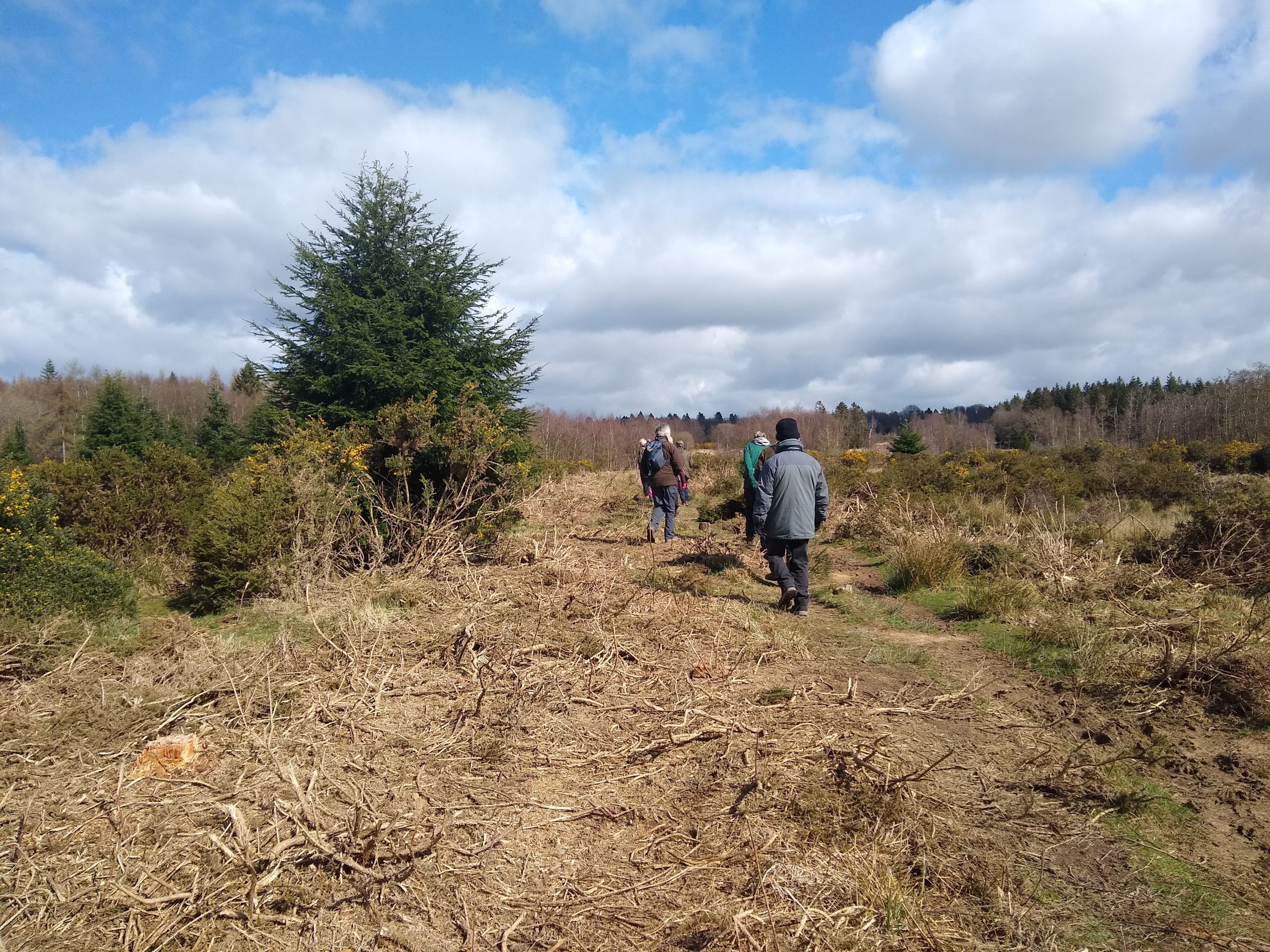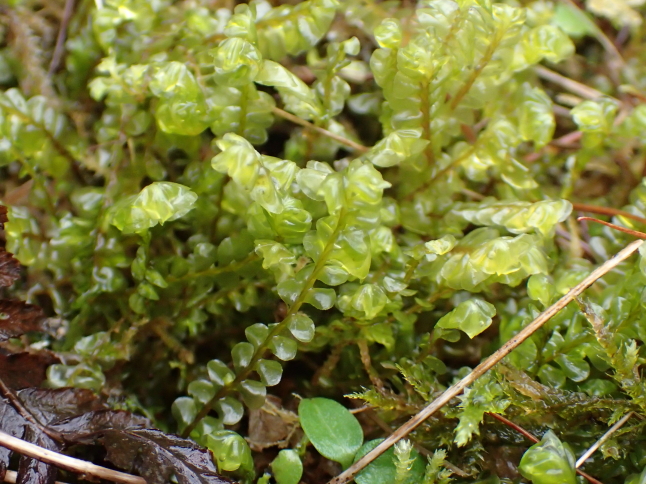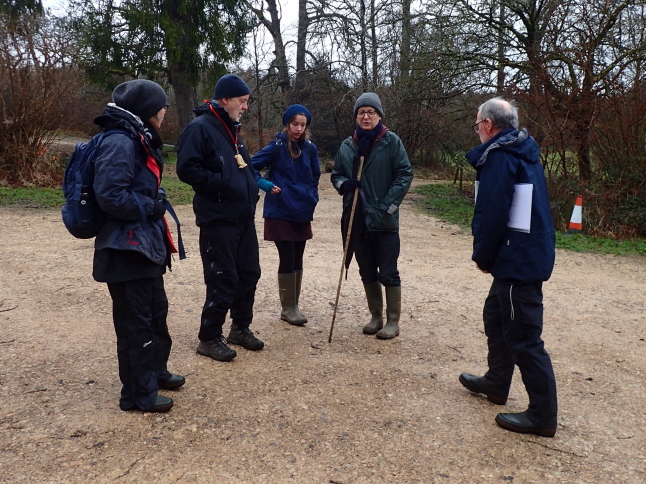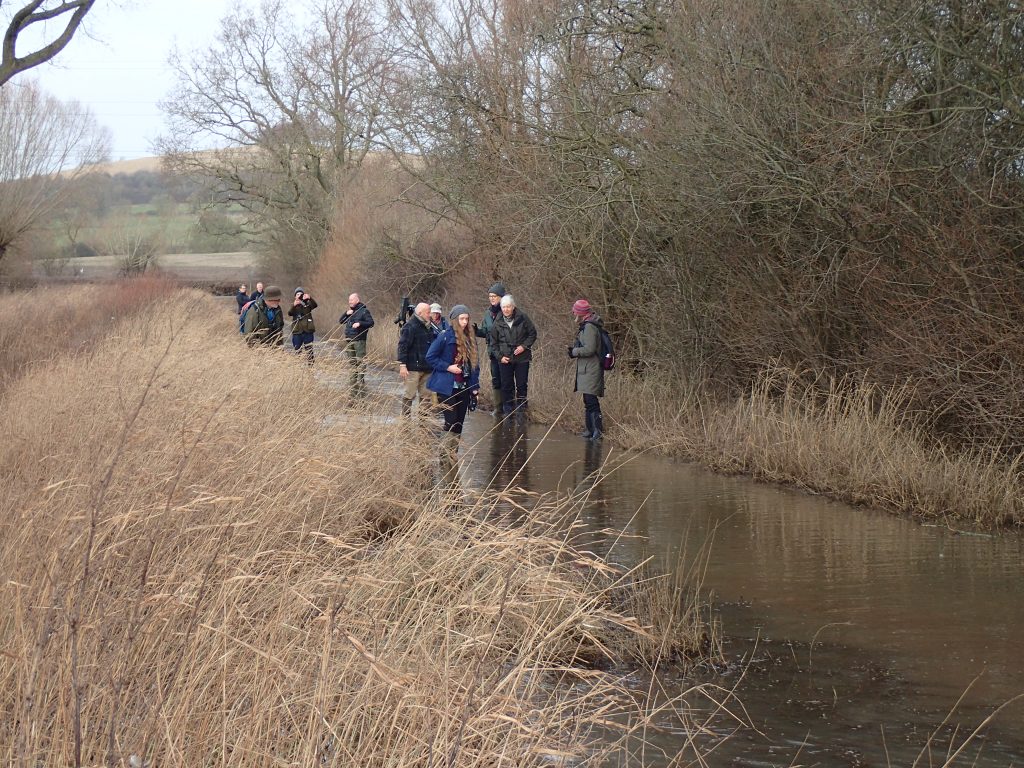Pasqueflower (Pulsatilla vulgaris), a rare member of the buttercup family, is just coming into bloom. It still can be seen on a few sunny grasslands on thin soils in the Cotswolds, attracting visitors from far away, this time Chris Heath while he was back on holiday from his job in Zambia. Pasqueflower means Easter Flower but with Easter so early they took some finding, even on this well-known site on the steep banks of Barnsley Warren. In early summer the purple petals are replaced by attractive feathery seed heads.
All news
Woorgreen and Crabtree Hill Sunday 24th March.
Good weather and a nice sized group, we were lucky to have some experts on hand so that a good range of species
could be identified. With one exception(reptiles) we managed to spot representatives of all the major groups.
On the botanical side we were able to distinguish between Evernia and Ramalina, both are similar lichens and we
even found the two species on the same twig making comparison more easy. Another pair of similar looking
lichens were Parmelia sulcata and Flavoparmelia caperata, the former being bluer green and the later more apple
green. Fungi were not surprisingly few and far between but a large though ageing specimen of the yellow Witch’s
Butter fungus Tremella mesenterica was found close to the top of Crabtree Hill. Also, a slime mould was found,
pink and globular it was not positively identified at the time but was most likely Lycogala epidendum sometimes
known as Wolfs Milk. The conifers were well represented and perhaps the most notable were the Larches (our
deciduous evergreen!) these were just coming into leaf. Then it was a matter of deciding which species of Larch,
European or Japanese or even the hybrid, examples of both were found. Towards the end of the meeting, we
found some Horsetails just poking their heads skywards and in terms of flowering plant there was a reasonable mix
but very few were in flower. Close to the carpark there was quite a lot of Wood-sorrel which is Oxalis, and further
round we saw Sheep’s Sorrel which is Rumex. The Wood-sorrel was in flower but perhaps more impressive than its
white nodding flower heads were the bright green, acid green leaves, the Sheep’s Sorrel was not in flower, another
month or so before its dotty red flowers appear.
In the animal kingdom we managed a few invertebrates including a deceased dung beetle, a mix of bees feeding
on a willow species that was in flower and one Peacock Butterfly that was enjoying the sun.
There were a lot of tadpoles in a stream the flows along the lower section of Crabtree hill, it was agreed that they
seemed to be a quite an advanced stage for the time of year, not quite getting their back legs but not far off, just
as well because the water course they were living in is not permanent and is normally dry in the summer. Whether
they were destined to become frogs or toads, the group had mixed views on that.
No reptiles though the weather was warm enough to bring out a lizard or adder, but none were spotted.
Birds were not in great evidence but with about 18 keen pairs of eyes on the lookout we did manage a reasonable
list but nothing that exciting. Mike Daw keeps a mental note of what is seen and supplied me with this list:
Great Tit, Long-tailed, Tit, Blue Tit, Coal Tit, Nuthatch, Robin, Wren, Siskin, Chaffinch, Chiffchaff,
Treecreeper, Goldcrest, Blackbird, Mandarin Duck, Mallard, Canada Goose, Raven, Goshawk, Buzzard.
Before the meeting commenced at 10.30am there were a couple of Carion Crows around the car park and on the
way round some members with good hearing picked out a Blackcap singing along with Woodpigeon and Mistle
Thrush.
We did see about 4/5 young Fallow deer running across the path and they successfully jumped the fence that
surrounds the site, no signs of cattle or ponies on this visit. Plenty of evidence though of Wild Boar both their
digging and their droppings.
Thanks to all who attended and the expert knowledge that was shared with the group.
Snowshill field meeting cancelled
Please note that the field meeting that was due to take place at Snowshill this Sunday the 17th March has been cancelled. The location was checked in advance of the meeting and was found to be very muddy to the point of being dangerous. It will be rescheduled for a later date and hopefully better conditions.
Cyril Hart Arboretum, Forest of Dean
Sunday 25th and it was time to ID some Conifers, lead by Clare and Mark Kitchen, quite a task as 36 keen
Gymnologists turned up. Is there such a word? Well, if you can have Bryologists then why not
Gymnologists?
We made a start with the Monkey Puzzle Tree, or Chilean Pine, which we all knew but could we key it
out in a proper scientific way. It proved somewhat of a challenge as some of the questions were a bit
obscure and some of the terminology had to be explained to some of the onlookers. Eventually we got
there albeit, perhaps with some help because we knew where we wanted to end up.
Subsequent trees were less of a problem as folks became more used to the questions being posed in the
key. Bit by bit we made our way round the Arboretum stopping at selected trees to work our way
through the key which by now was becoming more and more familiar.
Possibly 36 was a tad too many but it showed the interest in this difficult group of plants and maybe
future visits would be in order but with numbers restricted to no more than 20.
GNS field meeting – Chedworth’s Bryological Byways
The phrase good weather for ducks could be adapted to good weather for mosses, especially as to
proliferate they need water so their antherozoids can swim, sperm like, to meet up with the ovule and
consummate their arrival by producing the diploid sporophyte phase of their lives and their next
generation.
An so it was on Thursday when a small group of GNS members were lead round Chedworth woods close
to the Roman villa by Pete Martin. Pete is joint organiser for the Gloucestershire branch of the British
Bryological Association but more to the point he is passionate about mosses and liverworts, and why
not? And has an amazing in depth knowledge so not only can he identify most of them he can also tell
you something about their life style, habitat preferences and all sorts of other interesting facts. Did you
know that the leafy liverwort Lophocolea smells strongly of camphor, moth balls?
The group was blessed by a short break in the rain we started off just after 10.00am as the rain abated
and progressed up a steep ish path skirting the edge of the Roman villa site, the path was running with
water and was more or less a stream. The mosses were observed using hand lenses and some were
rendered difficult to ID due to being saturated with rain water, great for the antherozoids on their way
to potential married bliss but difficult for Bryologists to make out the finer details of moss leaf
morphology.
The Bryophytes were subdivided into 4 broad groups, Mosses growing upright, mosses that are more
horizontal and feathery, Liverworts that are leafy and Liverworts that are thallose. Not perhaps 100%
scientific but easier to understand. We found representatives of all 4 groups with the feathery mosses
predominating.
Lunch was taken at around 1.30pm and the first drops of rain were then felt. This was in the vicinity of
an old railway line and tunnel, This, we then followed back to the car park stopping at times to observe
various species that were here growing on the limestone rocks that were exposed from the cutting of
the old rail line.
A lot of species were identified, too many to list here but the illustrated ones are in order of appearance.
Zygodon viridissimus
Plagiochila asplenoides
Plagiomnium undulatum
Homalothecium sericeum
Dicranum scoparium
Pellia endiviifolia
Radula complanate
Hylocomiadelphus triquetrus
AGM
The Society’s Annual General Meeting will take place on 27 March 2024 in the Ed Shed at the rear of the main Folk building, Westgate Street, Gloucester; 7.15 for 7.30 pm. The business element of the meeting will be fairly short and will be followed by a talk about Beavers in the Forest of Dean, and potentially elsewhere in Gloucestershire to be given by Kate Wollen.
Full details including where to park are on the attached flyer which can be downloaded and printed using this link –
Ashleworth Ham Field Meeting, Jan 24
Just over a dozen members met at the Gloucestershire Wildlife Trust’s (GWT) Ashleworth Ham reserve this morning, in the wake of named storm Jocelyn which had passed breezily through the previous evening, leaving a very pleasant morning – mild, windless and quite bright with good light for watching waterbirds. The meeting had originally been planned for mid-December but had had to be postponed because of the unusual series of major flood episodes, which have occurred since October 2023: the early first one in October/November (following storms Babet and the Ciaran),the second in mid-December following heavy snowfall higher up the Severn catchment in North Wales, and the third and highest in the first half of January as a follow-up to storm Henk. These three really big floods in such a short period had caused heavy flooding, and the Ham Road leading to the reserve had been impassable, with water several feet deep for weeks on end.
“Such deep flooding, here and at the other GWT reserve across the Severn at Coombe Hill, was paradoxically not to the ducks’ liking: if the water is too deep, dabbling ducks cannot reach down to the grass to feed and the height of the flooding had seen an exodus to other sites where flooding was not quite as deep, notably Mythe Hook above Tewkesbury and the Longdon basin just in south Worcestershire. One of the aims of this morning’s session was to check on whether the waterbirds had returned from these sites now that flooding was lower. At first sight only a few swans, geese and ducks could be seen on the floodwater, still fairly deep. There was a group of 18 wintering Mute Swans, which had clearly spent the night on an island where they were safe from foxes; many of them were last year’s cygnets which could be identified by the brown feathers in their plumage, but a couple were pairs of adults, the principal of which lost no time in throwing their weight about with puffed-up wings and chasing off other adults, a sign that they were beginning to hold territory, with breeding in mind. About 100 wintering Canada Geese were present (together with a Greylag x Canada Goose hybrid (or “Canlag”), feeding on the water’s surface, no doubt getting ready to move away in the near future to breeding areas in the Midlands and further north. Among the ducks (most of which will have come from breeding areas across central and northern Europe, as fa as Russia) the soft monotone of Teal could be heard from under all the flooded hedges, suggesting that there could be good numbers present, together with the louder whistle of Wigeon; a few elegant Pintail and heavy-billed Shoveler also showed, with the odd Gadwall, Mallard and Tufted Duck. Also present was a flock of 150 Lapwings, undoubtedly wintering birds from further east, probably continental Europe; good to see a reasonable flock of this species, whose local breeding population has decreased sharply in recent years. Initially, it didn’t look as though there were more than a few hundred ducks present, until a couple of shots from a nearby pheasant shoot flushed all the birds from the water and flooded fields behind the hedges, and we realised that a good two thousand ducks had been hiding on site, the majority Teal (probably 1200) and Wigeon (perhaps 700) with about 50 Mallard, 20 each Pintail and Shoveler and five Gadwall. They flew round, high in the air, providing a fine spectacle, before returning to the water, where we were able to study them at leisure from the hides overlooking the reserve.
“Among other birds present were a Buzzard and a few passerines, mainly small flocks of Great and Blue Tits and the inevitable crows – rather little birdsong as yet, just the odd Robin and Wren. Nothing unexpected, but a good selection of the typical wintering species of this major floodplain reserve, which in a few short months will be welcoming a variety of breeding birds, many of them currently south of the Sahara. The floods had only very recently revealed the bare ground in the meadows, but from a public footpath we were able to see that the array of plants found on the rich hay meadows were already beginning to appear with leaves of buttercups already showing through.
GNS Photographic Competition finalists
In case you weren’t able to join us for the presentation of the finalists’ submissions to the 2023 GNS Photographic Competition, and the announcements of the winners, you can now download a PDF here. Thank you to everyone who took part!
Beaver visit – 16 January 2024
We were blessed with good weather, about as good as it gets in mid-January, fine blue skies, sunny and crisp, cold yes but this meant that the mud was frozen. We were met at the entrance by Kate Wollen and directed down to a region halfway along the beaver enclosure. We were given a short introductory chat about the conception and early history of the project. I won’t steal Kate’s thunder as she will be talking to the GNS members at the forthcoming AGM, she did say that the talk will include a lot of video footage of the Beavers in action. The site has lots of trail cameras to record their activities. Seeing a beaver in daylight is not very common and despite us all looking none were seen on this visit.
We did see the results of their activities, lots of trees felled including some quite large Oaks, some had had their branches removed for food or use in dam construction and others had been left. The beavers also start to fell some trees but then leave them only partially cut which results in standing deadwood. We saw several dams and what was particularly impressive was the head of water that they had managed to build up behind the dams, in one place in was almost a couple of meters above the water below the dam. Apples were placed out kebab fashion for the beavers to snack on, evidently, they normally get through the offerings in one night but certainly they will all be gone in two days. Camera traps are placed close to the apples so that good photos can be taken to check that the beavers are in good condition. Feeding them apples also helps when they might need to be trapped to move them as then apples are placed in the trap, and they are then used to feeding on them. Also, camera traps are placed close to the apples so that good photos can be taken to check that the beavers are in good condition no cuts or sores.
Kate was most informative, and the large group paid close attention to all she had to say. This was a very interesting meeting, and I am sure some members will be returning later in the year at dawn or dusk to see if they can catch a glimpse of the occupants. There are at present an adult pair and two kits, which now will be almost a year old, Kate expects that the pair will probably produce more offspring this year, and then later this year it will be time to catch and move the older youngsters to pastures new.
Alan Waterman
New Year Plant Hunt
The Plant Group’s New Year Plant Hunt was a cheerful affair with a large group of us wandering up the Miry Brook valley in Nailsworth, recording mostly the sorts of plants that happily grow in pavement cracks and cultivated ground. The aim of the exercise organised by the BSBI is to record wild plants that are in flower, and they have to be properly in flower with anthers showing, even if it is just one starved frost-bitten floret. Signs of spring were some early Primroses, Hazel catkins, a good clump of Lesser Celandine and a sole Barren Strawberry Flower. A few other flowers were relatively obvious – White Deadnettle, Daisy, Dandelion. The meeting ended with an essential pub session to compare lists. A very respectable 43 species was the final score with details available here https://nyph.bsbi.org/survey.php…. Thanks to the leaders Clare and Mark Kitchen and Olga Krylova.





